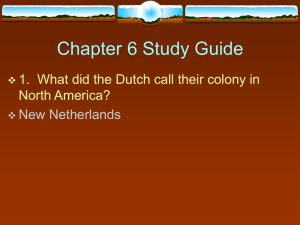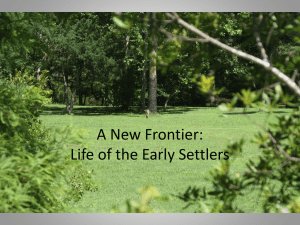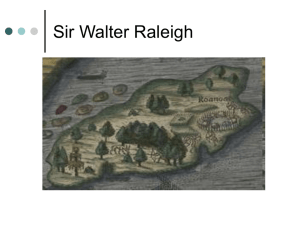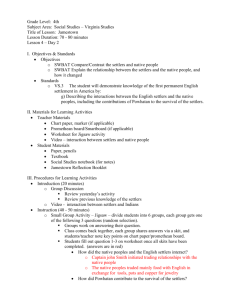The early days
advertisement
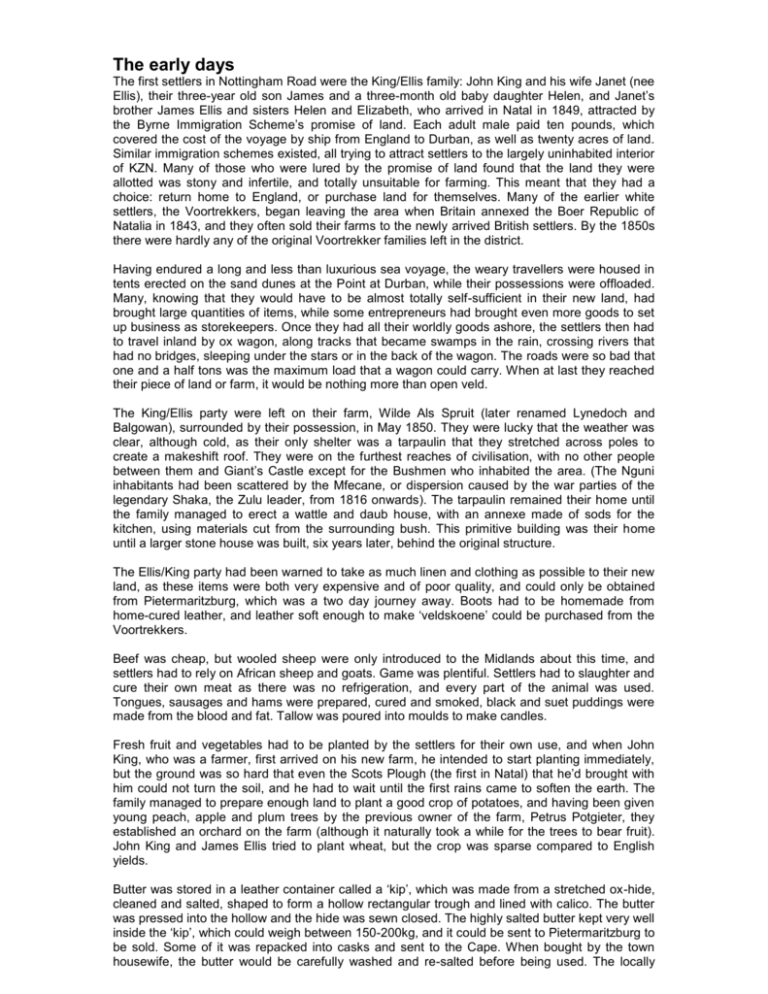
The early days The first settlers in Nottingham Road were the King/Ellis family: John King and his wife Janet (nee Ellis), their three-year old son James and a three-month old baby daughter Helen, and Janet’s brother James Ellis and sisters Helen and Elizabeth, who arrived in Natal in 1849, attracted by the Byrne Immigration Scheme’s promise of land. Each adult male paid ten pounds, which covered the cost of the voyage by ship from England to Durban, as well as twenty acres of land. Similar immigration schemes existed, all trying to attract settlers to the largely uninhabited interior of KZN. Many of those who were lured by the promise of land found that the land they were allotted was stony and infertile, and totally unsuitable for farming. This meant that they had a choice: return home to England, or purchase land for themselves. Many of the earlier white settlers, the Voortrekkers, began leaving the area when Britain annexed the Boer Republic of Natalia in 1843, and they often sold their farms to the newly arrived British settlers. By the 1850s there were hardly any of the original Voortrekker families left in the district. Having endured a long and less than luxurious sea voyage, the weary travellers were housed in tents erected on the sand dunes at the Point at Durban, while their possessions were offloaded. Many, knowing that they would have to be almost totally self-sufficient in their new land, had brought large quantities of items, while some entrepreneurs had brought even more goods to set up business as storekeepers. Once they had all their worldly goods ashore, the settlers then had to travel inland by ox wagon, along tracks that became swamps in the rain, crossing rivers that had no bridges, sleeping under the stars or in the back of the wagon. The roads were so bad that one and a half tons was the maximum load that a wagon could carry. When at last they reached their piece of land or farm, it would be nothing more than open veld. The King/Ellis party were left on their farm, Wilde Als Spruit (later renamed Lynedoch and Balgowan), surrounded by their possession, in May 1850. They were lucky that the weather was clear, although cold, as their only shelter was a tarpaulin that they stretched across poles to create a makeshift roof. They were on the furthest reaches of civilisation, with no other people between them and Giant’s Castle except for the Bushmen who inhabited the area. (The Nguni inhabitants had been scattered by the Mfecane, or dispersion caused by the war parties of the legendary Shaka, the Zulu leader, from 1816 onwards). The tarpaulin remained their home until the family managed to erect a wattle and daub house, with an annexe made of sods for the kitchen, using materials cut from the surrounding bush. This primitive building was their home until a larger stone house was built, six years later, behind the original structure. The Ellis/King party had been warned to take as much linen and clothing as possible to their new land, as these items were both very expensive and of poor quality, and could only be obtained from Pietermaritzburg, which was a two day journey away. Boots had to be homemade from home-cured leather, and leather soft enough to make ‘veldskoene’ could be purchased from the Voortrekkers. Beef was cheap, but wooled sheep were only introduced to the Midlands about this time, and settlers had to rely on African sheep and goats. Game was plentiful. Settlers had to slaughter and cure their own meat as there was no refrigeration, and every part of the animal was used. Tongues, sausages and hams were prepared, cured and smoked, black and suet puddings were made from the blood and fat. Tallow was poured into moulds to make candles. Fresh fruit and vegetables had to be planted by the settlers for their own use, and when John King, who was a farmer, first arrived on his new farm, he intended to start planting immediately, but the ground was so hard that even the Scots Plough (the first in Natal) that he’d brought with him could not turn the soil, and he had to wait until the first rains came to soften the earth. The family managed to prepare enough land to plant a good crop of potatoes, and having been given young peach, apple and plum trees by the previous owner of the farm, Petrus Potgieter, they established an orchard on the farm (although it naturally took a while for the trees to bear fruit). John King and James Ellis tried to plant wheat, but the crop was sparse compared to English yields. Butter was stored in a leather container called a ‘kip’, which was made from a stretched ox-hide, cleaned and salted, shaped to form a hollow rectangular trough and lined with calico. The butter was pressed into the hollow and the hide was sewn closed. The highly salted butter kept very well inside the ‘kip’, which could weigh between 150-200kg, and it could be sent to Pietermaritzburg to be sold. Some of it was repacked into casks and sent to the Cape. When bought by the town housewife, the butter would be carefully washed and re-salted before being used. The locally made cheese was also very good, apparently quite like Roquefort in taste. Peach wine was made by the settlers, and many of the Voortrekkers had their own ‘pot stills’ to make brandy, which was very popular and sold well, especially as there was no excise in the area. This homemade brandy was apparently of quite good quality, and was also used for medicinal purposes. Tea was an expensive luxury that was locked away for special occasions. Canny settlers would bring plentiful supplies of dried goods with them to tide them over until they could grow their own or could get back to Pietermaritzburg to buy more. They also had to ensure that they had everything needed to be totally self-sufficient, from crockery and cutlery to tools, needles and thread, farming and household equipment and medicines. Often, those possessions that they’d brought with them had been damaged by sea water when they were offloaded, unless they had been stored in zinc- or tin-lined cases. If repairs were necessary, the farmer had to manage them himself, as even the smallest bolt had to be sent to Pietermaritzburg to be fixed. In time, an old native blacksmith settled on Lynedoch, who used a huge stone anvil and bellows made of goat skins to effect basic repairs and make hoes and assegais, but more advanced mechanical repairs were beyond him. It is hard to imagine how lonely and strange life must have seemed to the new settlers. Most would have enjoyed a busy social life back in England, and the convenience of living in a town, or with at least a village shop, post office and doctor close by. For many families, months would pass before they saw another person, with the women especially homebound. They were largely ignored by the Voortrekker womenfolk, although the men were helpful and charitable. Evenings were spent sewing, doing leatherwork (making and repairing shoes, boots, belts and harnesses), or reading by candlelight. Children were expected to help on the farm, as native black labour was scarce and totally untrained. Even girls as young as three were expected to do their bit around the house, tending the vegetables, helping clean the house, prepare food, plant seeds into the furrows behind the oxen, or care for the livestock. Older children would ride out with the cattle in the morning and stay with the herd all day, herding the beasts back to the kraal in the evening. Few settlers could afford to send their children to the schools in Pietermaritzburg at a cost of a hundred pounds a year, and governesses for the wealthier families could not be persuaded to stay on the remote farms for long, so most children were educated at home by their parents. This was done in the evenings, as it was the only spare time when the family sat together. Imagine trying to get youngsters to study after a long day working on the farm, sitting on a cold floor, working by candlelight. It was only with the establishment of Hilton College in 1872 that children from the more distant parts of the Midlands could receive a formal education (boys only of course, education for women was considered a waste). A Mr and Mrs Thomas Greathead and their daughter also started a small school in Fort Nottingham in the 1860s. It was a double-storey building built of local wood with a thatch roof, and was eventually destroyed by fire. Over time the Greathead family also ran schools in Pinetown, Karkloof, Heidelberg and eventually at Caversham. Doctors and ministers were only to be found in Pietermaritzburg, and so the settlers had to tend their own ailments and injuries, as well as those of their animals, and see to their own religious needs. The bible was familiar to every household, often read aloud in the evening while the rest of the family attended to chores. A Presbyterian minister visited the area from Howick every quarter, travelling in a two-wheeled trap and holding services along his route, staying at farms as he went. An average day for the early settlers started before dawn, with the care of the animals. The family would enjoy a substantial breakfast together, which had to last until they met again at midday, when they would have a three-course meal. There was no mid-morning or mid-afternoon tea. The family had an early supper of bread, cheese, fruit and jam (all homemade) at about 6.30pm, with a glass of homemade wine and a biscuit before retiring to bed. Some of the worst problems faced by the settlers were posed by wild animals. Cattle and horses had to be kept inside a sturdy kraal at night, or be preyed upon by lions and other carnivores such as leopards and jackals, as well as the Bushmen. Even during the day, the animals had to be closely watched to ensure that they were not attacked. When sheep were introduced to the area, packs of wild dogs caused terrible losses to the flocks. The farmers also suffered the ravages of the elements, such as drought, floods and fires. It also took a while for them to understand the conditions and seasons of their new land after their years in the milder climate of England. But perhaps the most trying problem was the distance from the towns, which made it so difficult to sell produce, and to generate income from their new farming enterprises. It was only when the local population increased that they were able to sell locally, plus the road system improved and a railway network linking the interior to the rest of the country was developed, making it easier to send produce to larger towns such as Pietermaritzburg and Durban. But despite a life of discomfort, obstacles, loneliness and danger, these early settlers seemed to accept their new land, and seemed determined to make it their new home without complaint. The trials that they faced every day of their lives make our daily pressures seem trivial by comparison… Ends This story first appeared in The Quill newspaper (no longer in operation). Used with permission of the author and publisher.
